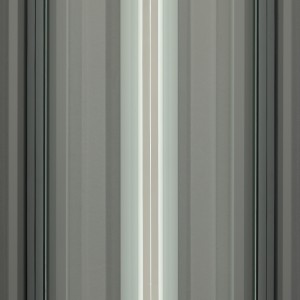Any rabid garden enthusiast visiting Los Angeles will probably want to put Robert Irwin’s Central Garden at the J. Paul Getty Museum on their list of places to visit. I’ve written about it a few times, including [ here ] and [ here ], and so have a lot of other bloggers. Robert Irwin is also involved in an installation of palm trees at the Los Angeles County Museum of Art.
The garden-making is a fairly recent addition to the projects of this amazing artist. Before taking on biological materials he created a rich body of work that plays with subtle ways you perceive light and space. Yesterday I had a chance to visit a show of some work in progress to see what he’s doing these days.

To look at this image to the left you’d maybe swear that this is a painting of stripes. But step into the gallery and you realize that these works are actually made out of evenly spaced fluorescent tubes, each of which has been wrapped in gels to modify their color and to provide linear patterns on the face of the bulbs. Most of Irwin’s art uses simple techniques like this, but the more you look, the more you get pulled into them.
The effects are so subtle photos can’t really do complete justice to the pieces. But the photographer, Philipp Scholz Rittermann, one of our local really talented camera guys, has made a beautiful interpretation.
You can see the vertical lines of the tubes, the lines of the dark gels, the subtle colors the tubes cast onto the fixtures and the spaces between them, and the delicate shadows of the fixtures. The tubes, the gels, the fixtures, the shadows–everything works together to give you a quietly rhythmic progression.

If I’m remembering the helpful gallery folks correctly, each piece has four different states, with different bulbs being on at different times. One of the big themes of the Getty garden is change–which really isn’t something you have to explain to a gardener–and these new pieces play with how different the same arrangement of bulbs appears as you turn some bulbs on and off.
Take a look at my garden photo at the top of this post, and look how the central topiaries of two kinds of clipped azaleas uses the subtly different leaf and flower colors to create interlocked formations. Next, look at one of the fluorescent bulb pieces and notice the subtle interplays of light and shadow that make up the work. It’s the same basic principle, but applied to wildly differing materials. As the plants in the garden go in and out of bloom, as the seasons change, the relationship of the formations shifts. Same goes for what happens when some bulbs are on and others blacked out.
I don’t often leave an exhibit thrilled and tingling, but this time I did. If you can make it to the exhibition at Quint Contemporary Art in La Jolla, go quick, before the show closes May 1. Or if you’ll be in New York in the fall, I believe I heard correctly that there’ll be a show of this work at the Pace Gallery.


Amazing! I’ve never seen anything like that. Thank you for the explanation.
Now this is why I garden–to make art, to tanslate, to transcend, to play and mix. For a while I was going to be an architect, then a painter, now I’m a writer (who gardens). All that math and theory and 2d sensorial stuff aside, gardening is the perfect blend / harmony of all arts. Am I wrong?
You described so well the effect of Irwin’s garden (I’m one of those bloggers who has written about it), and I was fascinated to see how he incorporates the idea of change into his other art works. The Getty gardens amaze me because they do “play with subtle ways you perceive light and space”, and because there’s always something new to see – as you move through the garden, and through the seasons.
Of course it helps to have a huge foundation-sponsored garden staff – which a friend who works at the Getty describes as the hardest-working group there.
Very cool! I wish I could see it in person.
Really cool. Wish I could see it in person.
A great way of looking at things. THanks for sharing. Cool stuff!
I wish I were closer – it’s very very cool.